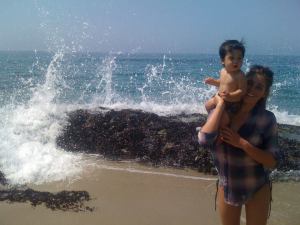Filed under: Uncategorized | Tags: Human impacts, Invasive species, Ocean, Pacific Garbage Patch, Plastic, Systems
Just about every piece of plastic that has been made still exists today. Only a small amount has been incinerated, which causes problems in itself because of the toxic chemicals released when plastic is burned. The petroleum in plastics cannot be digested by the Earth, and most of plastic trash ends up in our beautiful oceans.
The largest landfill in the world is located in the ocean. Millions of tons of trash, mostly plastics, get caught in ocean currents. The public often refers to the Great Pacific Garbage Patch as a vortex of chunks of trash between Hawaii and California. Many are misguided about large solid islands of trash floating in the ocean. The trash particles are significantly smaller in size, but exist in massive quantities.
Rather than biodegrade, plastics photo-degrade in the sunlight into microscopic pieces. Because of this process there are millions of micro-sized pieces of plastic, about .4 pieces of cubic meter, that are floating over an approximate area of 5000 square km of the pacific.
The fact that the majority of trash and plastics in the ocean are microscopic in size, rather than intimidatingly large mounds of accumulated trash, does not subtract from the harmful impact happening on the ocean’s ecosystem.
“Out of sight; out of mind” is a dangerous trend of societal thought.This way of thinking can lead to the mistake of overlooking the way in which human actions effect our Earth’s ecological systems. The ocean is a complex and unique earthly system. Recent research indicates that human development and activity has created a plastisphere that is altering the dynamic oceanic ecosystem.
The plastisphere, which is a term coined by marine biologist Erik Zettler, has created a platform of hard surfaces that invasive species thrive on. Creatures, like water skaters and others that usually cling to piers or ship hulls, have a larger presence in the ocean because of human-made hard surfaces of plastic in the ocean. Small particles of plastic settle and create hard surfaces for these invasive species which could potentially destroy native life that keeps the ocean in healthy balance.
Some larger animals in the ocean habitat are being killed from malnutrition and suffocation when they mistake plastic trash for food; a sad occurrence indeed. Yet, oceanic animals that are thriving because of the plastic trash are actually causing a larger discord in the oceanic ecosystem.

Two delicate life forms; Zeno Kai & the ocean
(Fun Fact: Kai means ocean in Hawaiian language, and naturally he adores the ocean)
It is important to understand that earth’s equilibrium relies on healthy functions of complex processes and systems. Every action has an effect. Human dependency on dispensable plastics is causing a measurable change in nature’s delicate ocean system. Aesthetic enjoyment is not the only motivation to keep trash out of our oceans. We can also learn to admire the ocean for the beauty of the intricate layers of life that it supports.Enabling a healthy flow and function of the oceanic ecosystem will require humans to make conscious choices about where they dispose plastic waste.
1 Comment so far
Leave a comment

Your ocean baby is beautiful! I hope you will keep informing people about the damage we do to this planet we call home. I do believe that the world is coming around, hopefully it will be soon enough to sustain our future generations, the one your holding in your arms and beyond!
Comment by jeanne December 3, 2012 @ 6:26 pm